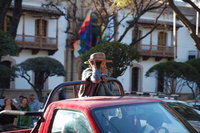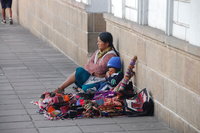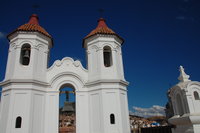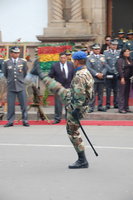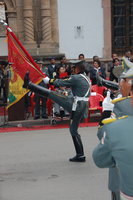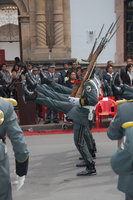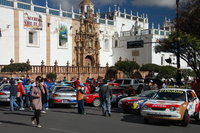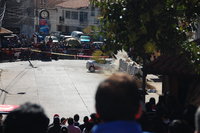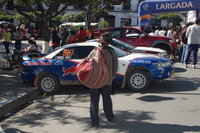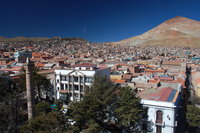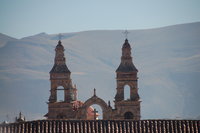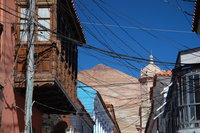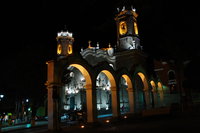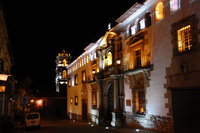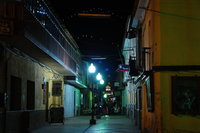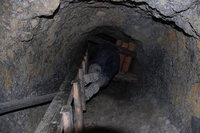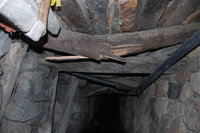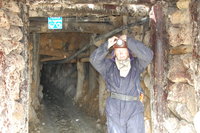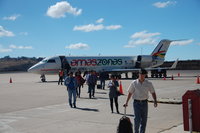
The Amazonas flight to Sucre is scheduled to take 29 mins. You know what is coming already! We actually took off 10 mins early which is weird and a little disconcerting. Not so weird, but rather more disconcerting is that about 5 miles out, we turned round and returned to Santa Cruz due to some unspecified technical problem. Upon landing we were told to return to the terminal for 10 mins (which is ominous). People with tool boxes appeared. Pilots disappeared. 10 mins turned into two hours. People with toolboxes disappeared. Two hours turned into four! The unspecified technical problem turned out to be that one of the ailerons on the plane had packed up (for the non-aviation minded, that meant we could only turn right!). Finally, we obtained a new plane and, sure enough, the journey lasted half an hour; with spectacular views of the eastern Andes. We had met a Dutch couple in Samaipata who were taking the overnight bus to Sucre (about 12 hours), so our 4 hours 29 mins didn't seem so bad.
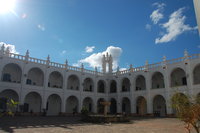
Sucre is billed the jewel of the Andes, but there is a bit more to it than that. Sure enough, a local law mandates that all buildings be whitewashed once a year which earns the city the nickname "The White City of the Americas" and it does gleam in the bright sunlight. It also has some of the finest Spanish colonial architecture in South America. It is a major university town and also home to a large number of indigenous peoples which makes for a very interesting and colourful mix. However, the city is not without its problems. There are piles of rubbish in the streets; something we certainly did not see in Santa Cruz. Then there is the chronic traffic congestion and noise. The city seems to be virtually gridlocked all the time. Lastly, there is the all-pervasive stench of urine, which seems largely down to the indigenous population micturating in every doorway. Of course, none of this is mentioned in any of the guide books and the taxi driver who brought us from the airport and enthused the whole way about his fair city omitted to mention these features either.
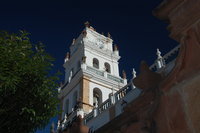
However, undoubtedly, this is a city of architecture and cafés and so, with a little bit of effort, is quite an enjoyable place to spend a few days. It's certainly hard to take pictures here due to the gleaming white everywhere and harsh shadows, but the climate is very conducive to ambling around soaking up the atmosphere (urine excepted).
Mathematically, we are right, slap bang in the middle of the dry season.
Between February and November it never rains here. You know what is coming yet
again, right? So, the heavens opened and it poured, much to the amazement of
the locals who decided they had been praying to the wrong gods. Unfortunately,
we had chosen this day to book a trip up to 3800m to hike part of an Inca
trail. Fortunately, even as we stood in the pouring rain, the guide insisted
that the trip would run. As we left the city, the skies cleared and we were
treated to a great hike in the Andes. No pictures of this as we had left the
camera behind due to the rain. The hike was largely down hill which is probably
a good thing at this altitude. We are hoping that this excursion will continue
the acclimatisation process as we head towards 5000m in the Altiplano in a
future instalment.
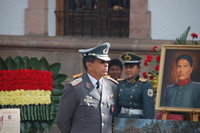
14th June is the day Bolivia remembers the heroes who fought in the so called Chaco War against Paraguay from 1932 to 1935. Since Sucre is the capital of Bolivia (really, it is), all the pomp and ceremony takes place here in the square, which is mercifully closed to traffic for once. From what we could see, two remaining survivors of that war were present and seated with the local dignitaries as the bands played and the marchers marched. The Bolivians got a right kicking from the Paraguayans (65000 died out of a population of 2 million), but this aspect did not feature in the celebrations. Fair enough, and the forces seemed to be putting a lot of effort into honouring their fallen. It was fascinating to see the be-medalled generals strutting around and once you realise that the loss of the Chaco War led to the formation of a government modelled on the Nazis, the comedy marching style becomes self explanatory (Bolivian marching powder jokes notwithstanding).
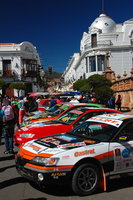
So, we had ended up with a spare day in Sucre having done everything we wanted to do and thought we might be at a bit of a loss. However, it turned out that the "Rally Oscar Crespo - Sucre" was taking place at the weekend and Saturday's stage started and ended in the main plaza in town. It seems that Bolivian rally cars are 90% noise and 10% duct tape which we found out as each car drove past our room at around 5am before parc fermé. We chose a strategic spot overlooking the first real bend at the end of a long up hill straight. We soon discovered that not all drivers realised that "crest into 90 right" means "slow down" and the scenery took a bashing! It was rather incongruous to see these rally cars against a backdrop of colonial architecture and to see indigenous people wandering around amongst them.
In the spirit of disrupted travel plans, we had decided to take the 10am bus to Potosi the next day only to find that the road from Sucre to Potosi would be closed as a rally stage was using it. The only way to make the journey was to catch the 6:30am bus.
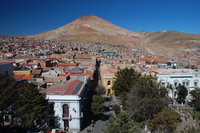
So, this city claims to be the highest in the world and, at nearly 4100m above sea level, that is entirely possible. It was also once the richest city in the world due to the proximity of the Cerro Rico (Rich Mountain). In 1545 a llama herder was lost on the mountain and lit a fire to keep warm. From out of the blaze ran a trickle of molten silver. As soon as the Spaniards heard of this, the mining began. By the beginning of the seventeenth century, Potosi was equal in size to London and produced more silver than anywhere else in the world. However, conditions for the miners were atrocious and over the 300 years of colonial mining, it is estimated that 9 million workers died. Now, the mountain is still mined, but for other resources such as tin and zinc although silver is still found. The conditions in the mines are still terrible and the miner's life expectancy is measured in years rather than decades due to arsenic poisoning and silicosis amongst other unpleasant ailments. Last year alone 12 miners died due to sickness or accident. All round a deeply unpleasant place! It is possible to visit the mines...
By day, Potosi was quite a pleasant place to hang out for us. We had acclimatised nicely in Sucre although the jump to over 4000m did leave us a bit breathless for a couple of days. There are many colonial buildings to visit some with great views over the city. It sometimes seemed as though the city streets had been aligned so as to always reveal a view of the Cerro Rico as it was virtually never out of sight - testament to its importance to the city both now and in the past. They say here "without miners there would be no Potosi". A highlight was a visit to the Royal Mint, where the mined silver was made into coins that were subsequently shipped all over the world. Much of the original machinery was still in place and it was possible to follow the process from where the silver arrived from Cerro Rico to the finished coins. There were only two other cities in Spanish America permitted to produce coins.
So, that was it for Potosi other than the small matter of the mine visit! The Rough Guide describes the mines as "unpleasant and highly dangerous [...] where safety precautions are largely left to supernatural forces", so we thought it was worth a look. We managed to find a guy named Wilson who alternates between working in the mine and guiding people through them (and he spoke some English which was a bonus). First we went to the miner's market where it is possible to buy everything a working miner might need including coca leaves, 96% proof alcohol and dynamite - a winning combination in anyone's book and particularly exciting 2km inside a mountain! So, we stocked up and the tour was on!
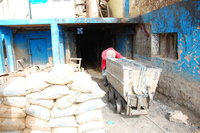
There are many different mines in the mountain, some run by the government and some by miner's cooperative. We entered through the cooperative run Rosario mine entrance. The entrance is splattered with llama blood to appease the spirits so that they don't take too many humans instead. Wilson advised us that we would be underground for around 2 hours and would cover about 3km before exiting the mountain via the Santa Elena mine. It is difficult to describe the dusty, fume-ridden atmosphere. It was hot, the ceilings were very low in places necessitating crawling. Occasionally, a cart laden with freshly mined ore would come thundering past at which point we had to get out of the way as they have no brakes and are pushed by the miners. We met many people working in the tunnels including one guy who was digging six holes each 50cm deep in the rock with a chisel and lump hammer. Later that day he would pack in the dynamite and see what happened. We distributed the gifts we had bought throughout the mine. At one point we came across a hole in the floor that dropped vertically down 200m to other abandoned tunnels. At another point, we had to climb a series of rickety wooden ladders to reach the Santa Elena mine. From there, we made our way towards the exit via a shrine to which the miners make offerings in the hope of rich pickings and a safe environment. Eventually, we emerged rather gratefully into the relentless sunshine rather more aware of how primitive and dangerous the Potosi mines really are.
Having done Potosi, we discovered that there were no scheduled blockades and so bought bus tickets to Uyuni, a desolate and wind-swept place on the Altiplano. We have a good reason for going there, but this will have to wait for the next episode.
That's it for now. Thanks for all the messages, we do seem to be able to get email reasonably regularly and it's nice to hear from you all.
We have not seen a single llama, alpaca or vicuña. It seems everyone farms sheep and goats these days. Not quite what we expected. There are plenty of internet cafés though!
